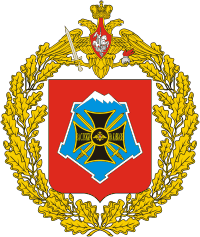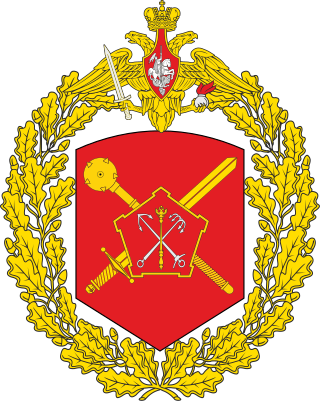| 12th Army | |
|---|---|
| Active | 1919–1920,1939–1943 |
| Country | |
| Branch | |
| Type | Infantry |
The 12th Army was a field army of the Red Army formed multiple times during the Russian Civil War and World War II.
| 12th Army | |
|---|---|
| Active | 1919–1920,1939–1943 |
| Country | |
| Branch | |
| Type | Infantry |
The 12th Army was a field army of the Red Army formed multiple times during the Russian Civil War and World War II.
The 12th Army (Russian Civil War 1st Formation) of the Soviet Red Army was first formed from Soviet forces in the north-eastern Caucasus in 1918.
The 12th Army (Russian Civil War 2nd Formation) was formed from the 1st and 3rd Ukrainian Red Armies in central Ukraine in the summer of 1919. In July 1920 Simon Aralov was chief of intelligence with this unit. it was disbanded in 1920. [1]
The 12th Army (1st Formation) (RKKA) of the Soviet Red Army was formed from the Southern (Cavalry-Mechanised) Army Group of the Kiev Special Military District during 1939–40. [2]
It was then involved in the Soviet invasion of Poland in 1939. It entered the Second World War as part of the Soviet Southwestern Front, comprising the
It participated in the frontier battle to the west of Stanislau. In the second half of July as part of the Soviet Southern Front it conducted defensive fights in the direction of Uman. During the Battle of Uman, the Twelfth Army was caught in a huge encirclement south of Kyiv along with the 6th Army. Thus the army's headquarters was disbanded on 10 August 1941, after the battle.
The 12th Army was reformed in August 1941 as part of the Soviet Southern Front on the basis of 17th Rifle Corps. [2] On 1 September 1941 its structure included 270th and 274th Rifle Divisions, the 11th Tank Division, 268th and 374th Corps Artillery Regiments, 64th and 181st Fighter Aviation Regiments, and a number of separate formations. [4]
The Army defended the left bank of the Dnepr around Zaporozhye, from the end of September to the beginning of December, 1941. It participated in the Donbas defensive, Rostov defensive and offensive, in January, 1942 in the Barvenkovo–Lozovaya Offensive operations, in the subsequent conducted defensive fights in Donbas and on Northern Caucasus (part of the Battle of the Caucasus). In the middle of April 1942 the 261st Rifle Division under Colonel A.M. Ilyin, the 4th Rifle Division (Colonel Ivan Rosly), the 74th Rifle Division under General F.E.Sheverdin, the 176th Rifle Division (General Vladimir Martsinkevich) and 54th Tank Brigade under Colonel K.S. Minarov were assigned to the Army.
It was later in 1942 reorganised as a defensive zone HQ, but then reformed again by conversion of the previous 5th Tank Army in mid April 1943. [5] It joined the Southwestern Front. Its structure included the 172nd, 203rd, 244th, 333rd and 350th Rifle Divisions and other formations. In April – July the Army was in Front reserve, and then participated in the Donbas and Zaporozhye offensive operations. In November the army HQ was disbanded, with its forces transferred to other armies.

The 1st Guards Army was a Soviet Guards field army that fought on the Eastern Front during World War II.
The 4th Army was a Soviet field army of World War II that served on the Eastern front of World War II and in the Caucasus during the Cold War. It was disbanded after the fall of the Soviet Union, with its divisions being withdrawn to Russia and disbanded.
The North Caucasus Front, also translated as North Caucasian Front, was a major formation of the Red Army during the Second World War.
The 4th Mechanized Corps was a formation in the Soviet Red Army during the Second World War.
A mechanised corps was a Soviet armoured formation used prior to the beginning of World War II and reintroduced during the war, in 1942.
The 110th Rifle Division was a formation of the Soviet Union's Red Army during the course of World War II, which was formed, dissolved, and re-formed three times throughout the war.

The North Caucasus Military District was a military district of the Russian Armed Forces from 1992-2010. Before 1992 it had been part of the Soviet Armed Forces since 1918. In 2010 it became the Southern Military District and lately also included the Black Sea Fleet and Caspian Flotilla.

The 6th Combined Arms Army is a field army of the Red Army and the Soviet Army that was active with the Russian Ground Forces until 1998 and has been active since 2010 as the 6th Combined Arms Army. Military Unit number в/ч 31807.
The 18th Army of the Soviet Union's Red Army was formed on 21 June 1941 on the basis of HQ Kharkov Military District and armies of the Kiev Special Military District.
The 9th Army of the Soviet Union's Red Army was a Soviet field army, active from 1939 to 1943.
The 8th Army was a field army of the Soviet Red Army during the Second World War.
The 99th Rifle Division was an infantry division of the Soviet Union's Red Army which fought in World War II. It was first formed in 1924, destroyed, reformed and raised to Guards status, and then reformed once again.
The 22nd Army was a field army of the Red Army during World War II.

The 44th Kievskaya of the Red Banner Rifle Division of Nikolay Shchors, or 44th Kievskaya for short, was an elite military formation of the Soviet Union. Created during the beginnings of the Russian Civil War. It was destroyed during the Winter War, after being ordered to help the 163rd Infantry Division break a Finnish siege on the Raate road as part of the Special Rifle Corps 9th Army, together with the 54th Rifle Division. Afterwards it was levied and dissolved multiple times through out the 40's and 50's until its final dissolution in 1959.
The 27th Army was a field army of the Soviet Union's Red Army, which fought in World War II.
The 2nd Mechanised Corps was a formation in the Soviet Red Army during the Second World War.
The 52nd Army was a field army of the Red Army of the Soviet Union in World War II, formed twice.
The 11th Tank Division was a Soviet tank division initially formed in 1940 at Tiraspol and destroyed in 1941; it was then formed as a tank corps in May 1942. This unit was subsequently reorganized as the second formation of the 11th Tank Division in 1945.
The 5th Mechanised Corps was a mechanised corps of the Red Army, formed on three occasions. It was first formed in 1934 and was converted into the 15th Tank Corps in 1938. It was reformed in the Far East in 1940 and moved west before the German invasion of the Soviet Union. It fought in the First Battle of Smolensk, losing large numbers of tanks in the Lepel counterattack. The corps was encircled in the Smolensk pocket and after breaking out was disbanded in late August 1941. Its third formation, from elements of the 22nd Tank Corps, occurred in September 1942. The corps fought in: Operation Little Saturn, Operation Gallop, the Second Battle of Smolensk, the Dnieper–Carpathian Offensive, and the Second Jassy–Kishinev Offensive. In September 1944, it became the 9th Guards Mechanised Corps.
The Donbas–Rostov Strategic Defensive Operation was a defensive operation of the Southern Front and the left wing of the South–Western Front of the Red Army on the territory of Donbas during the World War II. During it, the Donbas and Rostov front–line defensive operations were carried out.